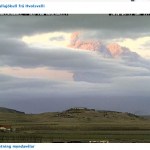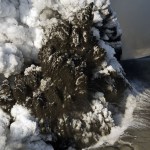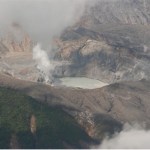Tourists hiking next to an active lava flow on Pacaya in Guatemala in 2006.
I'm flying back to Ohio today after a successful few weeks of fieldwork/paper writing. Apparently I have a pile of tomatoes waiting in our garden in Granville ... !
On to news:
To go with the news that lava flows from Kilauea creep ever closer to structures in Kalapana, the NASA Earth Observatory posts its first volcano image in a bit. The shot shows the steam-and-gas plume from the Halema`uma`u Crater in Kilauea's summit caldera. You can also see some video of the lava flows near Kalapana as they move along the…
eruption video
Dark ash covers an American Airline 737 on the tarmac at the airport in Guatemala City.
Two volcanoes are making headlines right now (and neither is in Iceland).
As I mentioned yesterday, Pacaya in Guatemala erupted (video) causing widespread disruption of life in the nearby Guatemala City and costing two people their lives (including a TV reporter who got too close to the vent). Almost 2,000 people have been evacuated from the region near the volcano. The BBC has posted some impressive video of the eruption of Pacaya, showing the strombolian explosions sending basaltic tephra high into the…
This week has been destroyed by workshops and my last death throes with a paper I am submitting on my research in New Zealand. And to think, I thought it might settle down a little after the students left.
To news!
Ash fall on a taxi cab near Guatemala's Pacaya.
Pacaya in Guatemala erupted yesterday causing evacuations of people near the volcano and the closure of Guatemala City's main airport. Pacaya is a mere ~25 km from the capitol of this Central American nation. Tragically, a news reporter from one of the capitol's TV stations died when they were struck by volcanic debris, again…
News, news, news!
Ash from Eyjafjallajökull piling up on a roof at Seljavellir. Image courtesy of the IMO, by Ari Tryggvason.
The latest from Eyjafjallajökull has the volcano continuing to puff away - producing intermittent airspace closures over Europe. The Icelandic Met Office reports a ~7 km (21,000 foot) ash plume, but they note that the explosivity of the eruption seems to have waned some since a maximum on May 13. Right now, the IMO estimates the eruption rate at ~200 tonnes/second. Lets put that in a little perspective - a Ford F-150 pickup weighs about 2 tonnes, so the volcano is…
Time to play a little catch up ...
Eyjafjallajökull erupting in early May. Image by and courtesy of Martin Rietze.
A brief update on our friend Eyjafjallajökull - the eruption plume from the volcano was considerably taller yesterday, reaching 6-9 km (20,000-30,000 feet), but prevailing winds meant the ash hazard was confined to areas in the middle of the North Atlantic and northern parts of the British Isles. However, even as the ash hazard for Europe wanes (for now), you shouldn't forget the amount of ash being dumped on parts of Iceland. If you want to see some stunning images of the…
An aerial view of Eyjafjallajökull erupting on May 11, 2010, with the extent of the black ash from the eruption on GÃgjökull clearly evident, along with the cracks in the glacier near the lava flow. Photo from the Icelandic Met Office, by Sigurlaug Hjaltadóttir.
Since this past weekend's disruptions due to Eyjafjallajökull, the air over Europe has cleared and most of the airports in Spain, Portugal and Germany (along with those in Morocco) have reopened. The current ash advisory by the London VAAC looks like it will only effect transatlantic flights and Iceland itself, with the ash cloud…
A shot of the strombolian activity at the vent of Eyjafjallajökull, taken on May 4, 2010. Image courtesy of the Iceland Met Office.
The latest news from the Eyjafjallajökull eruption has the volcano erupting more explosively again (see above), possibly due to an increased influx of water into the vent area - in any case, the ash has become denser (by volume in the air) and the plume is higher (see below) than in the last couple of weeks. The rate of lava flow extrusion has also gone down in the last few days. The latest update from the Iceland Met Office has a lot of details on the current…
Mt. Saint Helens erupting in 2004.
I had a chance to watch a new NOVA special that airs May 5 (PBS) on the 1980-1986 and 2004-2008 eruption cycles at Mt. Saint Helens, along with the recovery of the blast zone from the 1980 eruption. It is a fitting episode as we approach the 30th anniversary of the eruption that took out the north side of the volcano and devastated a vast swath of Cascade wilderness in Washington on May 18, 1980. Many of you have already sent me your Mt. Saint Helens memories (keep them coming!) for my tribute to the eruption, but if you want to get started on remembering…
News!
Colima in Mexico erupting in 2008.
The current activity at Eyjafjallajökull is more-or-less unchanged, with strombolian activity producing a 3-4 km tall ash-and-steam plume and the lava flows at the crater moving northward towards the GÃgjökull glacier. You can check out an extensive page on the state of this eruption at the Nordic Volcanological Center - along with a new page with thermal and LIDAR information on the eruption from France.
The Icelandic Met Office notes that the lava has been producing meltwater from the glacier - which many Eruptions readers have noticed as floods…
An undated painting of the island volcano of Ischia near the Bay of Naples, Italy.
Guess what? It is the end of the semester (well, school year) here at Denison, so I might be a little busy for the next couple weeks.
Here are some news bits (with special thanks to all who emailed me some of these links):
Boris might have more information or opinion on this, but Italy is back in the news concerning the threat of volcanism to the country. This time the volcano is Ischia, off the coast in the Bay of Naples. Guido Bertolaso of Italy's civil protection agency is quoted as saying that the "magma…
The ash-and-steam plume from Eyjafjallajökull on April 19, 2010.
Eyjafjallajökull in Iceland is slowly settling into a pattern of strombolian-to-surtseyan (depending on meltwater access to the crater) explosions that have been sending ash up to 2-5 km above the summit. We can see this new, more diffuse plume in the recent NASA EO image of the eruption taken April 19. There is still abundant ice to melt at the summit as there have been a number of floods overnight and this morning near the volcano, betraying the continuing production of meltwater by the eruption. The Icelandic Met office…
Eyjafjallajokull erupting on 4/17/2010, image by Marco Fulle. Note the "rooster tails" of ash and steam, typical for Surtseyan eruptions.
European airspace has slowly begun to reopen as the explosive eruptions at Eyjafjallajökull have become less intense over the last 24 hours. However, there is still lots of hazardous airspace and airports around places like London and across the UK remain closed - leaving people stranded. We will still have to wait to see what the political ramification are, especially after EU officials claim "flaws" in their decision and the over $1 billion losses by…
National Geographic film crew near Eyjafjallajökull, April 18, 2010.
UPDATE 1PM EDT 4/19/2010: I can almost categorically say that Hekla is NOT erupting, contrary to Twitter or the brief banner on MSNBC. See my comment below (#68).
In what is sounding like a bit of a broken record, the eruption at Eyjafjallajökull is still going. However, we might be beginning to see some changes in the style of volcanism - even the first suggestion of lava flows at the new crater. As mentioned yesterday, since the eruption became subglacial, we've been seeing eruptions where water - in this case glacial…
The steam-and-ash plume from Eyjafjallajokull in Iceland, March 22, 2010.
Overnight, the Eyjafjallajokull eruption in Iceland added to its oeuvre, producing what is being reported to be a 8-km plume. Images of the plume (above) suggest (to me) that it is very water-rich, so likely this is the expanding(?) fissure interacting with snow, ice or groundwater, producing steam explosions. These explosions have some minor ash component to them, mostly from the shattering of rapidly cooled lava, but are dominated by steam.
The eruption appears to be continuing into its third day unabated. Flights…
The fissure vent eruption on Eyjafjallajokull in Iceland on March 21, 2010.
The big news this morning is the eruption that started last night at Eyjafjallajokull in Iceland, producing a 1-km fissure vent. The pictures and videos I've seen so far have been quite impressive, with the classic look of a "curtain of fire", where basaltic lava erupts explosively from a linear array of vents - you can see the geometry in the image from the BBC/AP (above). Especially clear is the dual nature of the eruption, with both the explosive fire fountains and the effusive (passive) lava flows from the root…
The latest in my Volcano Profiles series, this one on Erta Ale in Ethiopia.
The summit crater at Erta Ale in 1994
Location: The Afar region of Ethiopia.
Height: 613 m / 2,011 feet
Tectonic setting: Erta Ale (meaning "smoking mountain") is part of the East African Rift, where the African Continent is tearing apart along a seam that runs from the Red Sea/Gulf of Aden (two other arms of the rift themselves) south through eastern Africa. Many of the large lakes of eastern Africa such as Lakes Albert, Tanganyika, Nyasa and Kariba fill rift valleys created by the cracking of the continental plate…
Some news for a busy Tuesday:
The crater at Poas volcano in Costa Rica, taken February 25, 2010. Image courtesy of OVSICORI by Federico Chavarria.
After the MSNBC debacle, it is nice to see some good articles on why the Chilean earthquake was overall less disastrous than the Haitian earthquake, why the tsunami wasn't as large as predicted and why these earthquakes are not abnormal. There are a lot of factors involved - the location, depth, preparedness, wealth - so the comparison can be very telling in terms of both geologic and societal issues.
The other scientific fallout from the Chilean…
A pyroclastic flow from the February 5 vulcanian eruption of Soufriere Hills. Image courtesy of the Montserrat Volcano Observatory (MVO).
UPDATE: See some amazing images of the recent eruptive activity over on Stromboli Online. {Hat tip to the Volcanism Blog via Eruptions reader CK.}
One event that didn't eat much coverage over the weekend, at least here in the U.S., was the large eruption and explosions at Soufriere Hills on Montserrat. The volcano has had a resurgent winter since have a quiet summer of 2009. This weekend's eruption produced an ash plume that reached ~6.1 km / 20,000 feet…
This is a request more related to my teaching, but I thought I'd ask here. I'm trying to find copies of the UNESCO videos "Understanding Volcanic Hazards" and "Reducing Volcanic Risk". They were made by the Kraffts to help educate people on volcanic hazards, especially in developing countries. I've seen them both and they are great for introductory geology classes. However, the one source I knew of - the NW Interpretive Assoc. - doesn't seem to carry them anymore - and even if they did, the only format I know of is VHS, which is getting woefully obsolete.
So, do any of you know where I might…
The plume from submarine volcano Fukutoku-Okanoba, erupting in February 2010.
Almost a year after the Hunga Tonga Hunga Ha'apai eruption, where an undersea volcano sprang forth from the deep - quite spectacularly, we have new footage of another undersea eruption. Fukutoku-Okanoba, off the coast of Minami Iwo, started to erupt yesterday (or, at least, erupt enough to manifest a plume out of the ocean). A Japanese coast guard vessel was able to capture the plume on video as it reached 100 m / ~300 feet. The plume appears to be dominated by white steam along with some grey ash mixed in.…


